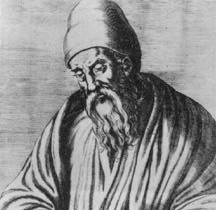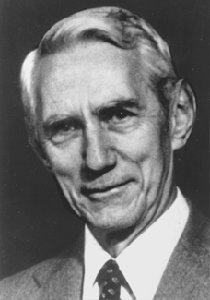 Picture courtesy
Eric's Treasure Troves
Picture courtesy
Eric's Treasure Troves
|
Thales (634 BC - 546 BC)Greek philosopher who is considered the founder of Greek science, mathematics, and philosophy. He visited Egypt and probably Babylon, bringing back knowledge of astronomy and geometry. He invented deductive mathematics. To him is attributed Thales' theorem . More at Eric's Treasure Troves ... MacTutor |
 Picture courtesy
Eric's Treasure Troves
Picture courtesy
Eric's Treasure Troves
|
Pythagoras (560 BC - 480 BC)Greek philosopher and mathematician who founded the mystic Pythagorean cult. The cult he founded was devoted to the study of numbers, which the Pythagoreans saw as concrete, material objects. They studied figurate numbers , More at Eric's Treasure Troves ... MacTutor |
 Picture courtesy
MacTutor
Picture courtesy
MacTutor
|
Zeno (490 BC - 425 BC)Zeno was a pupil and friend of the philosopher Parmenides and studied with him in Elea. The Eleatic School , one of the leading pre-Socratic schools of Greek philosophy, had been founded by Parmenides in Elea in southern Italy. His philosophy of monism claimed that the many things which appear to exist are merely a single eternal reality which he called Being. His principle was that "all is one" and that change or non-Being are impossible. Certainly Zeno was greatly influenced by the arguments of Parmenides and Plato tells us that the two philosophers visited Athens together in around 450 BC. More at
Eric's Treasure Troves
...
MacTutor
|
 Picture courtesy
Eric's Treasure Troves
Picture courtesy
Eric's Treasure Troves
|
Hippocrates (470 BC - 410 BC)Greek mathematician who squared More at
Eric's Treasure Troves
...
MacTutor
|

|
Eudoxus (400 BC - 347 BC)
|
 Picture courtesy
Eric's Treasure Troves
Picture courtesy
Eric's Treasure Troves
|
Archimedes (287 BC - 212 BC)Greek mathematician who flourished in Sicily. He is generally considered to be the greatest mathematician of ancient times. Most of the facts about his life come from a biography about the Roman soldier Marcellus written by the Roman biographer Plutarch. More at Eric's Treasure Troves ... MacTutor |

|
Aristotle (384 BC - 322 BC)Greek philosopher usually upheld as one of the greatest philosophers of all times. Aristotle studied at the Academy, but disagreed with Plato , feeling that one could obtain knowledge about the natural world. He distinguished between two types of philosophers: the physiologoi (natural philosophers) who study nature (e.g. Thales , Anaximander , and Anaximenes ) and the theologoi who used gods and myths (e.g. Homer and Hesiod ). Aristotle believed that there exists a "golden mean," or desirable middle ground between any two extremes. He founded his own school in Athens called the Lyceum (or "peripatetic school," since Aristotle used to lecture while walking) which emphasized natural philosophy. More ... |

|
Plato (427 BC - 347 BC)Greek philosopher who was a student and follower of Socrates . He founded the Academy school in Athens. His works consisted of "dialogs" between Socrates and others. Like Socrates , he was interested in moral, not natural philosophy. He believed that the heads of government should be "philosopher kings" and developed a course of study stressing abstract thought for their education in the Republic. Plato advocated the "quadrivium" (the four math fields of study in the liberal arts), which starts with arithmetic, then progresses to plane geometry, solid geometry, and finally astronomy and harmonics. Plato believed that knowledge was "forgotten" at birth, and could be remembered. He saw the search for understanding as an attempt to gain pure knowledge, or "forms". More ... |
 picture taken from
Eric's Treasure Troves
picture taken from
Eric's Treasure Troves
|
Euclid (ca. 325 - ca. 270 BC)Euclid's greatest accomplishment was the Elements , his 13-chapter book outlining everything he knew about geometry. He based all of his geometrical theorems on just five postulates, making the work very rigorous and complete, but for two millenia mathematicians wondered if the fifth postulate (the so-called "Parallel Postulate") could in fact be derived from the other four. This was finally answered (in the negative) by Lobachevsky, Bolyai, and Gauss, leading to the branch of mathematics we now call Non-Euclidean Geometry . More... |

|
Al-Karaji, Abu Bekr ibn Muhammad ibn al-Husayn (953 - ca. 1029)Al-Karaji's work centered around algebra and polynomials, giving rules for arithmetic operations to manipulate polynomials. Woepcke describes his work as introducing the "theory of algebraic calculus". Stemming from this, Al-Karaji investigated binomial coefficients and Pascal's triangle. Additionally, Al-Karaji used induction to prove his results. More... |
 picture taken from
Eric's Treasure Troves
picture taken from
Eric's Treasure Troves
|
Fibonacci, Leonardo de Pisa (ca. 1170 - ca. 1240)The Fibonacci numbers are taught to schoolchildren around the world as a fun and interesting mathematical diversion. The numbers have an intimite relationship with the golden ratio the Greeks so admired, and with Euclid's GCD algorithm, making them more significant than Fibonacci probably anticipated when he posed his original problem involving rabbits. Besides the numbers named after him, Fibonacci wrote important books that revived classical Greek mathematical knowledge, on such subjects as the place-value system and geometry. More... |
 picture taken from
Eric's Treasure Troves
picture taken from
Eric's Treasure Troves
|
Pascal, Blaise (1623 - 1662)In his short life, Pascal made contributions to many fields of science. He was possibly the second person ever to create a mechanical calculator, and ran many barometric experiments. However, much of work focused on mathematics, including geometry (particularly conic sections), probability theory, and the "Arithmetical Triangle" (known today as "Pascal's triangle"). More... |

|
Leibniz, Gottfried (1646-1717)More... |
 photo taken from
Eric's Treasure Troves
photo taken from
Eric's Treasure Troves
|
Euler, Leonhard (1707-1783)Leonhard Euler made contributions to just about every area of mathematics. Some of his more famous results included many theorems about Complex Numbers (introducing the symbol i for the square root of -1), his theorem on Eulerian circuits that led to the development of Graph Theory, and his discovery of the closed form for the Fibonacci numbers. More... |
 photo taken from
Eric's Treasure Troves
photo taken from
Eric's Treasure Troves
|
Gauss, Karl Friedrich (1777-1855)Karl Friedrich Gauss was one of the most prolific and influential mathematicians in all of history (second only to Euler if anyone), in spite of the fact that he was a perfectionist and did not publish many of his discoveries. He made lasting contributions not just to number theory, geometry, and calculus, but also physics and astronomy. Among other things he is known for discovering how to sum consecutive integers at a very young age, and for his Prime Number Theorem. More... |

|
Galois, Evariste (1811-1832)More... |
 photo taken from
Eric's Treasure Troves
photo taken from
Eric's Treasure Troves
|
Cantor, Georg (1845-1918)Georg Cantor was a German mathematician who introduced the mathematical world to the amazing concept of measuring the cardinality of infinite sets, but unfortunately most of his contemporaries did not like his ideas because they were so radical and disturbing. He discovered that the real numbers are not countable, but the rationals are. When not working on mathematics, Cantor tried to prove that Francis Bacon actually wrote Shakespeare's plays. More... |

photo taken from MacTutor |
Polya, George (1887 - 1985)More... |

photo taken from MacTutor |
Kolmogorov (1903 - 1987)In the context of the course, Kolmogorov is associated with randomness and incompressibility. However, he made many contributions in other areas, ranging from set theory and Markov processes to probability and physics. His outstanding career brought many honors from many countries, including Russian, American, and British organizations. More... |

|
Church, Alonzo (1903-1995)More... |

|
Godel, Kurt (1906-1978)More... |

|
Turing, Alan Mathison (1912-1954)Alan Turing was one of the fathers of computer science. His theoretical contributions included the formalization of an abstract machine ("Turing Machine"), the proof that the halting problem was uncomputable, and a philosophical treatise on Artificial Intelligence (the "Turing Test"). Just as significantly, though, he was a key player in the Allies' breaking of the German Enigma cipher in WWII - with a combination of pure mathematics and an ingenious machine Turing helped build, the Allies were able to crack every new German cipher within hours. More... |

photo taken from: Information Science Hall of Fame |
Shannon, Claude (1916 - 2001)In 1936, Claude Shannon graduated from University of Michigan with Bachelor degrees in Electrical Engineer and Mathematics. This dual interest was this key to his later work. He then went to M.I.T. and spent time working with the Bush differential analyzer, a mechanical device that solved differential equations. He recognized that the machine was a two-valued system, ideally suited for Boolen algebra. His ideas were refined at Bell Labs and subsequent years at M.I.T. leading to a vacuum tube version called the Bush Rapid Selector. Out of his research came our modern notions of computers, information theory, and communication networks. More... |

photo taken from Profiles of Women in Mathematics |
Robinson, Julia (1919-1985)Julia Robinson was the first female mathematician elected to the National Academy of Sciences and the first woman president of the American Mathematical Society. Initially, she enrolled in college to receive public school teaching credentials, but became involved with number theory. In particular, she demonstrated that the notion of an integer can be derived from the notion of rationals. Most of her work was focussed on solving Hilbert's tenth problem, finding an effective method to solve diophantine equations. More... |

|
Karatsuba, Anatolii Alexeevich (1937-)Anatolii Karatsuba is a Russian mathematician who is best known for discovering the first multiplication algorithm that runs in less than O(n2) time - specifically his algorithm is O(n log2 3) or about O(n 1.58 ). He has also written papers on such diverse areas as finite automata theory and the Riemann Zeta function. He enjoys mountaneering and is currently the head of the Laboratory of Analytic Number Theory at the Steklov Mathematical Institute in Moscow. More... |

|
Cook, Stephen (1939 - )Cook was born in Buffalo, NY and completed his undergraduate education at the University of Michigan. He earned his Ph.D. in Mathematics from Harvard, then moved on to teach at U.C. Berkeley until 1970. Since then he has taught at the University of Toronto. His principal research area is computational complexity, with excursions into programming language semantics, parallel computation, and especially the interaction between logic and complexity theory. Cook is best known for his formulation of the notion of NP-completeness and his proof that satisfiability is NP-complete. He has published about one hundred papers in theoretical computer science, including fundamental results in parallel complexity. More... |

|
Chaitin, Gregory (1947 - ) "Gregory Chaitin is at the IBM Watson Research Center in New York.
In the mid 1960s, when he was a teenager, he created algorithmic information
theory (AIT), which combines, among other elements, Shannon's information
theory and Turing's theory of computability. In the three decades since
then he has been the principal architect of the theory. Among his contributions
are the definition of a random sequence via algorithmic incompressibility,
and his information-theoretic approach to Gödel's incompleteness
theorem. His work on Hilbert's 10th problem has shown that in a sense
there is randomness in arithmetic, in other words, that God not only plays
dice in quantum mechanics and nonlinear dynamics, but even in elementary
number theory. His latest achievement has been to transform AIT into
a theory about the size of real computer programs, programs that you can
actually run. He is the author of six books: Algorithmic Information
Theory published by Cambridge University Press; Information, Randomness
& Incompleteness and Information-Theoretic Incompleteness,
both published by World Scientific; and The Limits of Mathematics,
The Unknowable and Exploring Randomness, all published
by Springer-Verlag. In 1995 he was given the degree of doctor of science
honoris causa by the University of Maine, and he was elected to the IBM
Academy of Technology. In 1998 he was named visiting professor at the
University of Buenos Aires." |